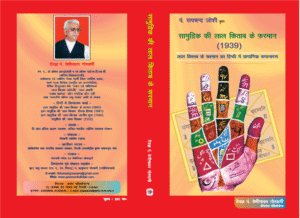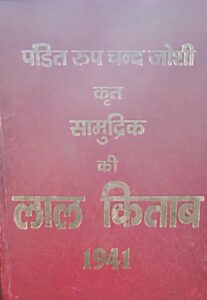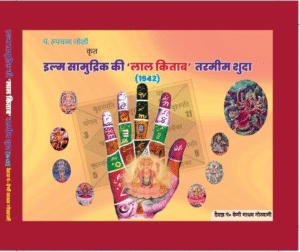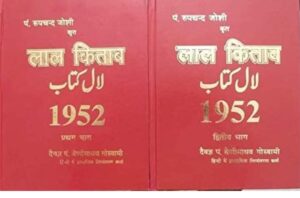ilm samundrik ki lalkitab 1939

The original ilm samundrik ki lalkitab 1939 TRANSLITTERATED PAGE by PAGE PARA by PARA as it is………… Lal Kitab by Pandit Roopchand Joshi (पं. रूपचंद जोशी की लाल किताब) and transliterated by Pt. Beni Madhav Goswami and Pt. Ribhukant Goswami.
This is the first published volume of Lal Kitab.
Each major topic in this volume is presented as a “Farmaan”, meaning an edict or pronouncement. The book contains a total of 181 Farmaans spread across over 383 pages, along with a 16-page index.
Although the contents of this volume lay the foundation for Lal Kitab astrology, the dominant theme is palmistry and Samudrik Shastra. The term Samudrik (meaning “of the ocean”) refers to knowledge believed to have originated from the oceans (samudra), and is traditionally used to describe the study of physical features and their connection to destiny.
Detailed discussions are provided on the shape and size of nails, fingers, palms, toes, as well as other aspects of physiognomy, including the shape of the skull, feet, forehead, and the lines and markings on these body parts. These signs and symbols are directly connected to planetary influences, which form the core basis of astrology.
As a result, the interpretation of palmistry in this volume is significantly different from that found in classical Indian or Western palmistry texts.
In addition to palmistry, many astrological concepts based on the Lal Kitab system are also introduced. This volume is extensively illustrated, and most of the sketches were personally drawn by Pandit Roop Chand Ji himself.
Ilm samundrik ki lalkitab ke armaan 1940

The original Ilm samundrik ki lalkitab ke armaan 1940 TRANSLITTERATED PAGE by PAGE PARA by PARA as it is………… Lal Kitab by Pandit Roopchand Joshi (पं. रूपचंद जोशी की लाल किताब) and transliterated by Pt. Beni Madhav Goswami and Pt. Ribhukant Goswami.
This is the second published volume of Lal Kitab and is perhaps the rarest of all the volumes.
It was written as a companion volume to the 1939 “Farmaan” edition. Readers are clearly warned that reading this volume without the 1939 edition may prove to be confusing.
While the first volume emphasizes palmistry and aspects of Samudrik Shastra, this second volume shifts the focus towards astrology. It introduces the basics of a horoscope and the foundations of Lal Kitab astrology. When both volumes are read together, one begins to perceive the close interrelationship between a person’s palm and horoscope.
Page and line numbers from the first volume are frequently referenced throughout this text.
Pandit Roop Chand initially intended to include both palmistry and astrology in a single volume. He had set a personal deadline to finish and publish that first volume in 1939. However, for personal reasons, he could not include the astrology section at that time. As a result, he presented the “Farmaans” (edicts) in the first volume and the “Armaans” (aspirations) in this second volume, published in 1940.
Each major topic in this volume is introduced as an “Armaan”, and just like the first volume, this book also contains exactly 181 Armaans (chapters).
The effects of all nine planets in each of the twelve houses are described in brief. Additionally, the combined effects of two or more planets in a single house are also discussed. Several unique concepts specific to Lal Kitab are introduced in this volume, including:
- “Masnoohee” (artificial) planets
- “Baalig” and “Nabaalig” (the “adult” and “minor” conditions of planets)
- Lal Kitab Chandra Kundali, and others.
The concept of Varsh Phal (annual progressed chart) is also mentioned, although not discussed in detail. However, various illustrative tables are provided to help practicing astrologers assess the strength and nature of planets before beginning actual predictions. This specific analytical methodology section has not been repeated or expanded upon in any of the later volumes.
For serious students of Lal Kitab, studying this analytical section would be a valuable and rare opportunity.
Ilm samundrik ki lalkitab teesra hissa 1941 gutka

This is the third published volume of Lal Kitab.
The original Ilm samundrik ki lalkitab teesra hissa 1941 gutka TRANSLITTERATED PAGE by PAGE PARA by PARA as it is………… Lal Kitab by Pandit Roopchand Joshi (पं. रूपचंद जोशी की लाल किताब) and transliterated by Pt. Beni Madhav Goswami and Pt. Ribhukant Goswami. This volume stands out due to several unique features. Firstly, it is presented in a compact pocket book (Gutka) format. Secondly, it introduces Lal Kitab astrology in a summarized and easy-to-understand format. To facilitate easier learning, Pandit Ji makes extensive use of verses in his writing.
“Because verses are much easier to remember than prose, Pandit Ji decided to incorporate them to help readers memorize the basics of Lal Kitab,” explains Pandit Som Dutt. As a result, numerous Lal Kitab practitioners have memorized these verses and often quote them in their practice.
This is also the only volume in which Pandit Roop Chand Ji briefly hints at how he came into astrology and how this divine knowledge was passed on to him by a “ghaibee taaqat” (unseen power). He writes:
“Kyaa huaa thaa, kyaa bhee hogaa,
Shauq dil mein aa gayaa
Ilm-e-jyotish, hast rekha,
Haal sab farmaa gayaa.”
And later…
“Haal sab graha khana waale,
Copy pe likhwaa gayaa.”
For the first time in the Lal Kitab series, this volume specifies numerous important remedial measures. It also introduces the amazingly simple “Varshphal” table, a powerful tool for making annual progressed horoscopes. Furthermore, a method is described for fine-tuning progressions down to the month, week, day, hour, minute, second, and even degree.
Unlike other volumes, this one contains almost no information on palmistry; astrology is the dominant focus throughout the book.
Ilm samundrik ki lalkitab tarmeeenshudha 1942

THE ORIGINAL LAL KITAB 1942 TRANSLITTERATED PAGE by PAGE PARA by PARA as it is………… Lal Kitab by Pandit Roopchand Joshi (पं. रूपचंद जोशी की लाल किताब) and transliterated by Pt. Beni Madhav Goswami and Pt. Ribhukant Goswami is one of the most authentic book (Lal Kitab) & one of the best ever transliterated. Lal Kitab is actually known for cheap remedial suggestion in Indian astrology. In this method that I feel that planets which are giving adverse effects in our life, performing some action, that is to neutralise that particular planet’s effects in individual life. If particular planet effects are examined in charts carefully and effected planets are detected wisely, then certain negative planets counter with doing some effective action for particular planets. People’s will power also engaged in that time give tremendous favourable effects. It is also known that if evil planets are detect and according to Lal kitab such action is performed.
1952 edition (Astrology based on Palmistry)

The Lal Kitab, originally written by Pandit Roop Chand Joshi And Transliterted by Daivagya Pt. Beni Madhav Goswami and Pt. Ribhukant Goswami is one of the most revered texts in Indian astrology. Known for its unique and simplified approach to Vedic astrology,
it combines astrological predictions with practical remedies,
often using household items or spiritual practices.
This 1952 edition, published in Hindi, is a timeless treasure for those seeking a deeper understanding of planetary influences and their effects on everyday life.
This book offers a detailed exploration of planetary placements, their impacts, and remedial measures that are easy to implement. Whether you are a beginner or a seasoned astrologer,
this volume serves as an invaluable guide to interpreting horoscopes and navigating life’s challenges.
